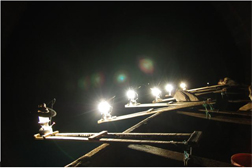Kerosene-powered night fishing untapped market for clean lighting, study

Night fishermen in the lake and ocean areas of Tanzania spend up to half of their take-home income on buying kerosene for lighting and maintaining their lamps, a new study has found.
Yet they could catch just as much fish using clean modern lighting systems powered by renewable energies such as solar, and eliminate these huge (35-50% of income) fuel costs.
According to the study authors, Tim Gengnagel, Philipp Wollburg and Evan Mills, Tanzanian fishermen use as much kerosene as would about one million ordinary households due to a combination of higher intensity pressurized lanterns and longer operating hours.
“We identified a significant market potential for the uptake of LED lighting by night fishermen, which could justify retooling and marketing investment on the part of lighting manufacturers. We estimate an existing expenditure on the order of $70 million per year for fuel and lamps by fishermen across all of Lake Victoria, Lake Tanganyika, Zanzibar, and the ocean coastline on mainland Tanzania,” the authors say.
The study, published this January by The Lumina Project, is titled “Alternatives to fuel-based lighting for night fishing; Field tests of lake and ocean applications in East Africa”, and was undertaken jointly by scientists at the University of Bayreuth, Germany and the Lawrence Berkeley National Laboratory, University of California, USA.
Many of the 12 to 18 million artisanal fishermen in developing countries fish at night using kerosene lanterns to attract fish into their nets. Tanzania’s lakes and oceans are a major center for this activity, involving over 100,000 lanterns used in 17,000 boats.
“This market is particularly ripe for LED lighting alternatives,” emphasize the authors. “Night fishermen have exceptionally high baseline costs for fuel, and lamp purchase and maintenance. While smaller in aggregate, the fishing market is in many ways easier to reach (being) … more concentrated geographically (around lakes and shorelines).”
According to the study, the cumulative retail value of LED systems that would provide the same lighting service is $17 to 21 million, plus $6 to $7 million per year in replacement expenditures. And the authors see a quarter of this market as being low hanging fruit that is relatively easy to reach in the medium term.
The study interacted with 113 individuals in the artisanal fishing sector and local experts to determine current practices, and conducted user-centered tests of LED-based system usability, performance and energy savings potential in the field including 121 netting rounds over multiple nights, 73 with LED lighting and 48 with kerosene lamps.
The study also estimated the market sizes for today’s fuel-based lighting in fishing, and scenarios of transition to improved products in these waterways. It can be read in full here.

